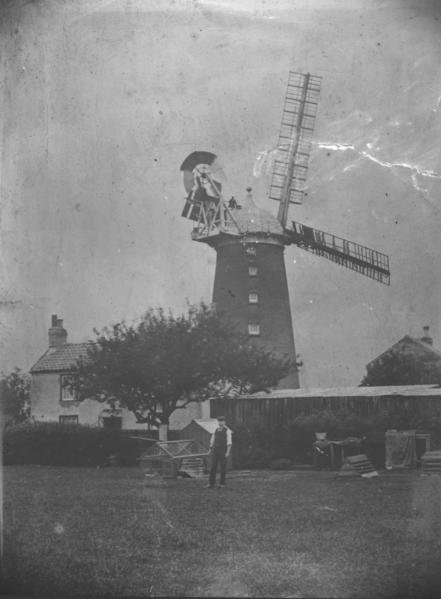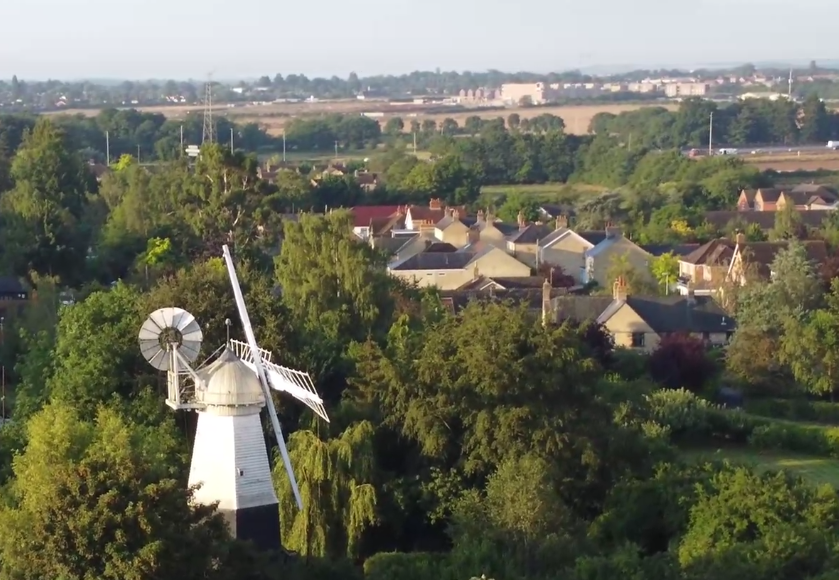Exploring Cambridge’s energy-generation: past, present, and future
As United Nations Climate Change Conference (COP 26) meets in Glasgow in November 2021, volunteers at Cambridge Museum of Technology have been exploring Cambridge’s energy landscape: past, present and future.
Back to the future: wind power in Cambridge
Wind power has a long heritage on the Cambridge skyline. The silhouette of windmills was once commonplace in and around town. A pop-up exhibition in Cambridge Museum of Technology and a presentation at Cambridge Industrial Archaeology Society “The Industrial History of the Hurst Park Estate” illustrates the presence of a windmill (in what became a suburban area of north Cambridge) that was working until about 1918 and was demolished in 1957.
Chesterton Mill, also owned by the French family during the 19th century, ground corn into flour with wind power, before switching to steam-power in the early-20th century and later to diesel-engine.
Photographed derelict, without cap, sails or windshaft in 1977, the site has since been refurbished into workspaces.
Chesterton Mill, 1977 © The Mills Archive Trust.
Another (preserved) local example is Impington Mill, where wind-powered machinery has operated at since at least the 17th century. The mill was rebuilt several times in the 18th and 19th centuries. During the 20th century, the mill was converted to run by steam traction engine, before its sails were removed in 1930. In the 21st century, new owners have re-fitted sails and restored machinery, with the aim of bringing the mill back to working order.
Impington Mill, view south-west, August 2021 by Matthew Power Photography for The Willcox Collective, commissioned by Cambridge Museum of Technology
In the 21st century, wind generation has returned to the outskirts of Cambridge: 13 wind turbines, each with a diameter of 90 metres and a combined nominal power of 26 megawatts (MW), dot Wadlow Farm, visible in the hills to the south-east of the Museum.
Photo: Cambridge Museum of Technology (chimney) south-east over Marshall’s aerodrome (centre) to Wadlow Wind Farm (rear right) by Matthew Power Photography for The Willcox Collection, commissioned by Cambridge Museum of Technology, June 2021
Victorian steam power (recycled)
The Hathorn Davey steam engines, preserved at Cambridge Museum of Technology, were powered by steam from water boilers that were originally heated by burning the town’s waste.
20th-century gas energy and electrification
Over the last century, two sites of carbon-based energy generation have disappeared from the Cambridge skyline. Cambridge University & Town Gas Light Company, which extracted synthetic gas from coke and stored the gas in holders, operated on River Lane from the 1820s to 1960s, before being replaced by North Sea gas.
Cambridge University & Town Gas-Light Company , 1928, Britain From Above EPW025466, © Historic England, licensed to Cambridge Museum of Technology
The coal-fired electricity generating station on Thompson’s Lane (the chimney of which was prominent among college spires by the 1920s) operated prior to construction of the national grid.
Chimney of Thompson’s Lane electricity generating station (centre) by river Cam 1920. Britain From Above EPW00050, © Historic England, licensed to Cambridge Museum of Technology
In 2020s Cambridge, solar panels are visible from a drone’s-eye view:
Photo: solar panels on rooftops, St. Matthew’s Piece from “2021: An Aerial Odyssey Around Cambridge” produced by Cambridge Museum of Technology
Want to find out more about Cambridge’s energy legacy?
You can explore more about Cambridge’s energy history by booking your visit to the Museum of Technology.
From a pop-up exhibition featuring Hurst Park’s windmill, to the steam, gas, and electric engines of the Cheddars Lane Pumping Station, to the remains of the Cambridge University & Town Gas-Light Company, and much more!
Subscribe to the Museum’s online channels and explore more of Cambridge’s industrial landscapes – past, present and future:
Acknowledgements
Hurst Park Estate History website
Britain From Above (Historic England)
Images reproduced with permission; copyrights reserved where indicated.









